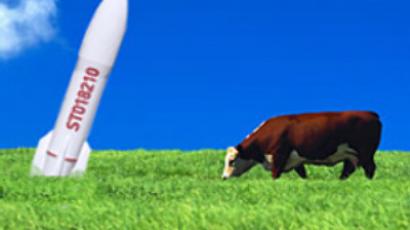Remembering famine - but when does mourning become too lavish?
With Ukraine suffering from the global financial crisis, officials in Kiev have been criticised for spending $23m on marking the 75th anniversary of the Great Famine of the 1930s.
On Monday, Ukraine’s President Yushchenko opened the mourning week, presenting the National Book of Memory of the victims.
Made by some 10,000 contributors, it included the names of 882,510 famine victims and 6,000 personal accounts of the events.
According to Yushchenko, the National Book of Memory is aimed at restoring historic truth about the Great Famine, also known as Holodomor. Ukraine’s President vowed that the 19 volume National Book of Memory was just the start of the research work that will eventually have the name of each Ukrainian victim uncovered.
Famine artifact presented
The book’s opening ceremony was in turn just the start of a series of events of the mourning week. An exposition titled “Holodomor of 1932-1933 – the genocide of the Ukrainian nation” also opened on Monday.
On Wednesday Yushchenko held an open remembrance lesson in one of the Kharkov high schools making several statements on Holodomor. He expressed hope that revealing the truth about the famine would bring more unity to the Ukrainian nation and called the pupils to “transfer the truth about the famine of 1932-1933 to their descendants and to research their family backgrounds paying attention to the events of 1930s”.
During the lesson, Yushchenko was presented a piece of bread kept since the famine by one of the families that had lived through it.
On Saturday the first half of a memorial in the Western Ukrainian village in the Sumy region was unveiled.
The ceremony was attended by leaders of Georgia, Latvia and other countries, not including Russia. The latter’s President Dmitry Medvedev wrote a letter in which he slammed the politicisation of the Great Famine.
In a separate ceremony Gareth Jones, a Welsh journalist who wrote about the famine back in the 1930s, was awarded Ukraine’s Order of Merit.
Expenses: second only to U.S.
The unfinished memorial in the Sumy region has already consumed some $23m from Ukraine’s budget. Estimates say the overall cost of the memorial will be $132-175m.
Ukraine’s Sevodnya daily compared the sum with budget expenditures on helping disabled people, $12.2m, and fighting TB and AIDS, $1.7m.
The German Holocaust memorial in Berlin cost just $36m, and only America’s billion-dollar memorial of 9/11 will beat the Ukrainian one in splendour. But its construction was postponed till 2012 due to the global economic turmoil.
Ukraine, however, is not scared of the crisis, and plans to proceed with its memorial.
Inciting genocide accusations
As the memorial is being built and commemorative events take place, experts still can't agree on the connotations of the Great Famine.
It was not just through the drought or the poor harvests that these people lost their lives.
Officials in Kiev claim the famine was “artificially engineered”, and blames Josef Stalin for a genocide targeted at Ukrainian people. This opinion is widely contested, as millions died not only in Ukraine, but also in Russian, Kyrgyz and Kazakh parts of the Soviet Union.
Russia insists that the famine of 1930s was not aimed at Ukrainians in particular, but was rather part of the whole USSR tragedy.
“We need to be on the objective side of the whole problem. We need to talk about lives of lost Russians, Ukrainians, Kazakhs and other peoples of republics that were members of the Soviet Union,” said Andrey Nesterenko, a spokesperson for Russia's Foreign Ministry.
The EU also has rejected the usage of the term ‘genocide’ twice this year: first in May, then in Ocobe, though condemning the event as “an appalling crime against the Ukrainian people, and against humanity”.
Several historians have named the Great Famine a stratocide – the elimination of a whole social class, a bloody implementation of Stalin’s decision to force peasants to give up their land and join collective farms.
“Stalin’s collectivisation policy was aimed at boosting urban development. Rural regions were seen only as the suppliers of resources to the cities,” says historian Aleksandr Ribko. “Foods and grain were extorted from the collective farms and given to urban regions. This policy took all available food from peasants.”
State Duma deputy Sergei Markov said that modern history textbooks in Ukraine have more falsified data than Soviet documents. He thinks that joint teams of Ukrainian, Russian and European researchers should write history textbooks in order not to incite inter-ethnic discord.
“Such an incitement is a criminal offence,” he said.
Steven Wheatcroft, an historian from the University of Melbourne, thinks that there is not any convincing evidence that the famine exclusively targeted the Ukrainian nationality.
“I do not think that the internationally accepted definition of genocide applies to the situation of 1933,” he said.
Documents made available
For decades after the famine Soviet authorities denied it had even happened. Now government papers from the time are available, shining light on one of the darkest chapters of Soviet history.
A small village in Russia’s Volga Region is just one of the many places that were devastated by the 1933 famine. At the time it was a large grain producer, but Soviet authorities took that grain and redistributed it to other parts of the country. That meant those who lived there went without food and many people died of starvation.
They were buried in a village cemetery with their graves marked with simple wooden crosses, yet many of the dead were not even granted this final dignity.
“I remember our neighbours dying. I was afraid to approach the bodies. We didn’t even bury them. We had no strength to dig the graves. Bodies just lay out in the open,” said one of the villagers.
“Our entire village was starving. My mother used to send us to pick rotten potatoes to make pancakes. We also ate leaves and grass,” said Zinaida Plotnikova, a famine survivor. “People were swollen with hunger. During that year my grandparents, my brother and my aunt’s four little children all died.”
Related links
Medvedev slams Ukraine’s Great Famine stunt
Why is Ukraine talking about famine?
EU: Stalin planned Ukrainian famine
Europe rejects Ukraine’s famine claim














